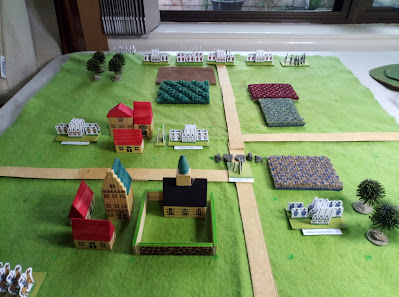The past couple of days I have been pondering an alternative activation system system for my ECW Portable Wargame. This was driven by the fact that the probability of scoring hits is fairly low which, oddly enough, I am happy with, but which combined with only around half the units on a side acting each turn led to some slow and static games. I had considered simply allowing every unit to act each turn, but wasn't sure I wanted to go there.
So I went for a compromise. I switched to a straight IGO-UGO system; moves alternate from one side to the other in a conventional manner. Then I followed this procedure:
On each turn the player rolls 1D6 for each unit they have in play.
Each score of '1' is assigned to a unit; those units cannot be activated this turn.
Each '6' is then assigned to a unit. They can act out of sequence.
Other units are activated according to the following rule. The player chooses to activate their units left to right, or right to left. Each unit is activated in that sequence. If there are multiple units in a file, the ones closest to the enemy baseline are activated first.
So units with a '1' assigned don't activate, and those with a '6' can be activated at any point during the player's turn. If you want to move a commander then a unit activation must be used - pick a unit and count it as having rolled a '1'.
It's simpler to play than explain.
Unfortunately it did make the random event system I used in these rules redundant, so I rolled for those at the start as well. I'm still pondering the best way to do this though.
Here's the battle from behind the Royalist position in Alton.
On the turn after this photos the two units fighting in the village destroyed each other. This pushed Parliament to their breakpoint.
I set up a second game (unphotographed), and this time treated a roll of '6' as a normal activation. This actually flowed much better. Having to activate your units in a set sequence does create a few restrictions, which I felt was good, and having to decide in advance which units you're going to assign the score of '1' to was an interesting exercise.
I'm tempted to even consider rolls of '1' or '2' as a failed activation, but to either add in a dice for the commander or simply assume that if he's active he generates a free activation - for example if you have six units you will get one activation plus 6D6 rolls worth. I'll have to set up some more games and see how that plays out; I think it will offer a nice compromise between 'nearly everything acts' and 'About half your force acts', with the commander activation helping smaller forces (since the free activation is worth more). Plus work out how to run random events.













Interesting idea. A bit more free flowing than usual?
ReplyDeleteI was getting somewhat frustrated by low activation levels in recent games, and considering ‘all activate’ with randomly assigned sequence using numbered tokens, OR Bob’s system from When Empires Clash, where a player assigns activation order then dices to see how many units get to go (D12 or 2D6). Looking forward to any further reports (and always good to see Alton being played!).
Yes, I felt the game flowed better. I'm hoping to try a game this evening using the 3+ for an activation, one free activation for the commander and some random events and see how that goes.
Delete